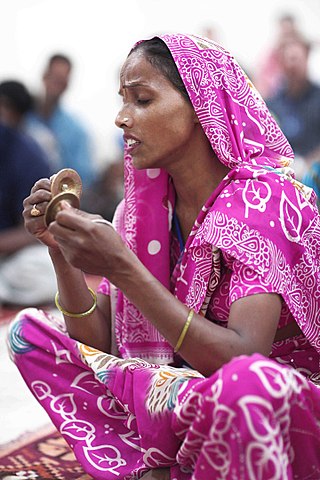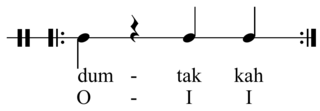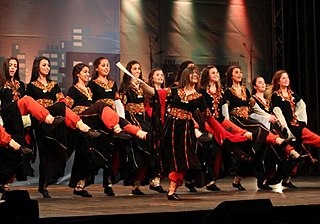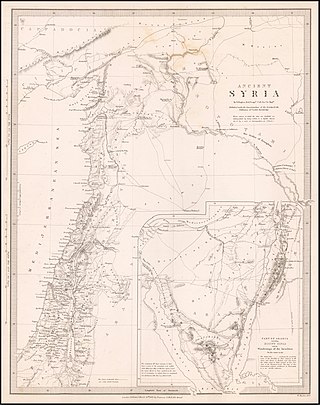
Carnatic music, known as Karnāṭaka saṃgīta or Karnāṭaka saṅgītam in the South Indian languages, is a system of music commonly associated with South India, including the modern Indian states of Andhra Pradesh, Karnataka, Kerala, Tamil Nadu and Telangana. It is one of two main subgenres of Indian classical music that evolved from ancient Hindu texts and traditions, particularly the Samaveda. The other subgenre is Hindustani music, which emerged as a distinct form because of Persian or Islamic influences from Northern India. The main emphasis in Carnatic music is on vocal music; most compositions are written to be sung, and even when played on instruments, they are meant to be performed in gāyaki (singing) style.

Bhajan refers to any devotional song with a religious theme or spiritual ideas, specifically among Dharmic religions, in any language. The term bhajanam means reverence and originates from the root word bhaj, which means to revere, as in 'Bhaja Govindam' . The term bhajana also means sharing.

Indian classical music is the classical music of the Indian subcontinent. It is generally described using terms like Marg Sangeet and Shastriya Sangeet. It has two major traditions: the North Indian classical music known as Hindustani and the South Indian expression known as Carnatic. These traditions were not distinct until about the 15th century. During the period of Mughal rule of the Indian subcontinent, the traditions separated and evolved into distinct forms. Hindustani music emphasizes improvisation and exploration of all aspects of a raga, while Carnatic performances tend to be short composition-based. However, the two systems continue to have more common features than differences. Another unique classical music tradition from Eastern part of India, i. e. Odissi music has evolved since two thousand years ago.
Arabic music is the music of the Arab world with all its diverse music styles and genres. Arabic countries have many rich and varied styles of music and also many linguistic dialects, with each country and region having their own traditional music.

Kurdish music refers to music performed in the Kurdish languages and Zaza-Gorani languages. The earliest study of Kurdish music was initiated by the renowned Armenian priest and composer Komitas in 1903, when he published his work "Chansons kurdes transcrites par le pere Komitas" which consisted of twelve Kurdish melodies which he had collected. The Armenian Karapetê Xaço also preserved many traditional Kurdish melodies throughout the 20th century by recording and performing them. In 1909, Scholar Isya Joseph published the work "Yezidi works" in which he documented the musical practice of the Yazidis including the role of the musician-like qewal figures and the instruments used by the minority.

The music of Palestine is one of many regional subgenres of Arabic music. While it shares much in common with Arabic music, both structurally and instrumentally, there are musical forms and subject matter that are distinctively Palestinian.

A tala literally means a 'clap, tapping one's hand on one's arm, a musical measure'. It is the term used in Indian classical music similar to musical meter, that is any rhythmic beat or strike that measures musical time. The measure is typically established by hand clapping, waving, touching fingers on thigh or the other hand, verbally, striking of small cymbals, or a percussion instrument in the Indian subcontinental traditions. Along with raga which forms the fabric of a melodic structure, the tala forms the life cycle and thereby constitutes one of the two foundational elements of Indian music.

Islamic music may refer to religious music, as performed in Islamic public services or private devotions, or more generally to musical traditions of the Muslim world. The heartland of Islam is the Middle East, North Africa, the Horn of Africa, Balkans, and West Africa, Iran, Central Asia, and South Asia. Due to Islam being a multi-ethnic religion, the musical expression of its adherents is vastly diverse. Indigenous traditions of various part have influenced the musical styles popular among Muslims today. The word "music" in Arabic, the language of Islam, is defined more narrowly than in English or some other languages, and "its concept" was at least originally "reserved for secular art music; separate names and concepts belonged to folk songs and to religious chants".

Rhythms in Arabic music are rich and very diverse, as they cover a huge region and peoples from Northern Africa to Western Asia. Rhymes are mainly analysed by means of rhythmic units called awzan and iqa'at.
Madih nabawi, one of the principal religious genres of Arabic music, is a song form dedicated to expressing praises, love and devotion for the Islamic prophet Muhammad and his family. The genre dates from 632 CE, immediately after the death of Muhammad, but the performers address Muhammad. It is also a Sufi genre of belletristic Arab literature.
Muwashshah is the name for both an Arabic poetic form and a musical genre. The poetic form consists of a multi-lined strophic verse poem written in classical Arabic, usually consisting of five stanzas, alternating with a refrain with a running rhyme. It was customary to open with one or two lines which matched the second part of the poem in rhyme and meter; in North Africa poets ignore the strict rules of Arabic meter while the poets in the East follow them. The musical genre of the same name uses muwaššaḥ texts as lyrics, still in classical Arabic. This tradition can take two forms: the waṣla of the Mashriq and the Arab Andalusi nubah of the western part of the Arab world.

Sabah al-Din Abu Qaws, also known as Sabah Fakhri, was a Syrian tenor singer from Aleppo.

The various nations of the region include the Arabic-speaking countries of the Middle East, the Iranian traditions of Persia, the Jewish music of Israel and the diaspora, Armenian music. Azeri Music, the varied traditions of Cypriot music, the Turkish music of Turkey, traditional Assyrian music, Coptic ritual music in Egypt as well as other genres of Egyptian music in general. It is widely regarded that some Middle-Eastern musical styles have influenced Central Asia, as well as the Balkans and Spain.

Dabke is a Levantine folk dance. Dabke combines circle dance and line dancing and is widely performed at weddings and other joyous occasions. The line forms from right to left and the leader of the dabke heads the line, alternating between facing the audience and the other dancers. In English, it can be transcribed as dabka, dabki, dabkeh.
Arabic hip-hop is a segment of hip hop music performed in the Arabic-speaking world. Due to variety of dialects and local genres which exist in the localities, Arabic hip-hop music may appear very diverse depending on the country of the song. Like most artists of the genre, the hip-hop artists from the Arabic-speaking world are highly influenced by American hip-hop.

Syrian chant is one of the oldest Christian chants in the world. Due to the lack of information concerning early musical manuscripts, it is conjectural to what extent the modern repertoire reflects the early traditions. What we know of the sound in Syrian chant is mainly derived from modern performances. Modern performances have a sparse texture and are highly ornamented. The setting within which Syriac chant takes place is, also only understood through the modern performances of Syriac chant. The chant seems to be designed to resonate throughout the building it is performed in. This suggests that the setting was always a church building or a room that reflected the sound of the walls and ceilings. There is some difficulty in studying Syrian chant due to the geopolitical conflict throughout Syrian Christian history. Many of the conflicts have resulted in persecution of Syrian Christians which may account for the oral tradition of Syriac chant. The history of Syriac chant is derived from diaspora and persecution.
Melody type or type-melody is a set of melodic formulas, figures, and patterns.

Yair Dalal is an Israeli musician of Iraqi-Jewish descent.

Sabri Moudallal was a singer and composer of traditional Syrian music, as well as a businessman.
In Judaism, musical nusach refers the musical style or tradition of a community, particularly the chant used for recitative prayers such as the Amidah.



















